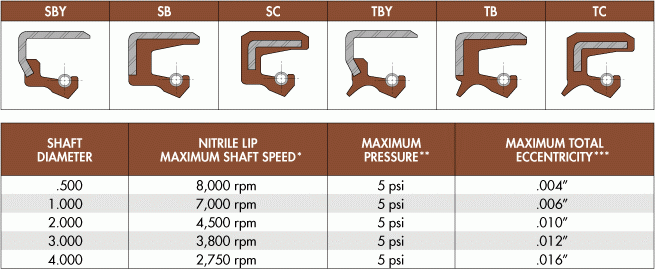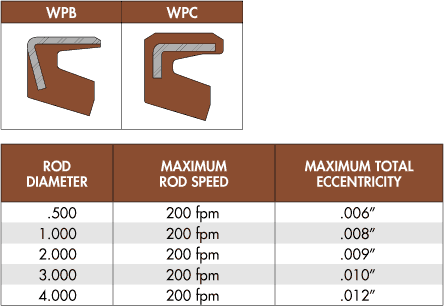|
|

  |
 |
 |
 HOW TO SELECT THE PROPER LIP DESIGN HOW TO SELECT THE PROPER LIP DESIGN
In order to select the proper seal design for an application, you must consider fluid pressure, shaft
eccentricity, temperature and fluid viscosity.
The sections below briefly discuss each standard lip designs most common applications, its limits of
tolerance for shaft speed, eccentricity, and pressure at various shaft diameters. Testing in each
application is required to verify the seals design effectiveness.
 S AND T LIP DESIGNS AND PERFORMANCE DATA S AND T LIP DESIGNS AND PERFORMANCE DATA

The S and T spring-loaded designs are the two most commonly used. The garter spring in these
designs applies additional lip force against the shaft, thus enabling the lip to follow shaft rotation
more closely at higher RPMs. This ensures more positive sealing with lower viscosity fluids and
extends service life.
The S style is used for such applications as engines, drive axles, transmissions, pumps, and electric
motors. The T style is similar, but with a secondary lip for dirt exclusion. This secondary lip excludes
contaminants and keeps lubrication in place under the primary lip. This secondary lip is designed with
a net contact to the shaft minimizing heat generation. It is not intended as a sealing lip for external
fluids. Specialized designs in this section address external fluid sealing.
* Will tolerate slightly higher shaft speeds if high-temperature elastomer
materials are used, e.g. Viton1, silicone, hydrogenated nitrile, or Vamac1.
** Will tolerate slightly higher continuous pressure if the shaft speed is below
200 feet per minute.
*** Will tolerate higher eccentricity if shaft speed is low or if fluid viscosity is high.
1 Viton and Vamac are trademarks of the E.I. duPont Company and refer to
fluorocarbon elastomer and ethylene acrylic.
 V AND K LIP DESIGNS AND PERFORMANCE DATA V AND K LIP DESIGNS AND PERFORMANCE DATA
V and K are non-spring loaded designs normally used for sealing against grease or other viscous
fluid. They are also effective dirt excluders. V is single-lipped, while K has the secondary lip for
greater contaminant exclusion and lubricant retention. V and K are more limited in range of
application than S or T because they lack the spring-loading. However, they are less expensive,
and work well with higher viscosity fluids and lower RPMs. These designs are good dirt excluders for
electric motors and for such applications as vehicle wheels, and conveyor rollers.

* Will tolerate higher eccentricities at lower shaft speeds.
 "W" LIP DESIGNS AND PERFORMANCE DATA "W" LIP DESIGNS AND PERFORMANCE DATA
The W design was specially developed as a dirt excluder for reciprocating shafts in hydraulic or
pneumatic cylinders. It helps protect the metal components within the cylinder by preventing abrasive
contaminants from being drawn into the cylinder on the rod.

|
|
|
|






